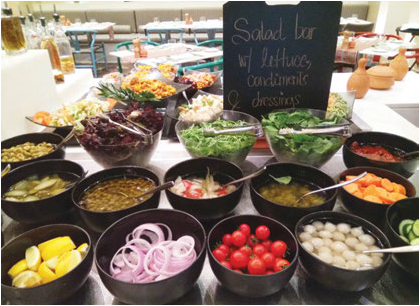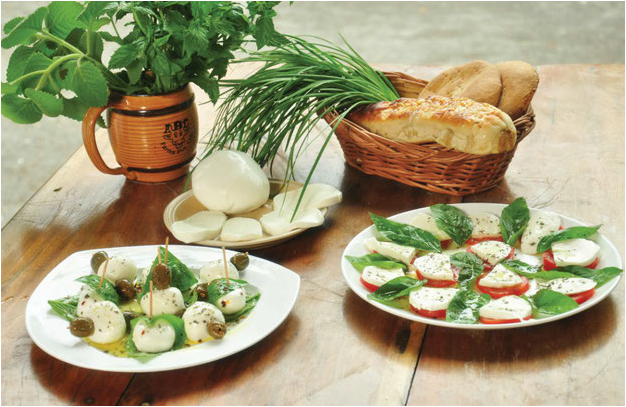THE CULTURAL HOTSPOT OF THE REGION, MUSCAT IS A POTPOURRI OF TRADITION, HERITAGE AND MODERNITY WOVEN TOGETHER SEAMLESSLY TO GIVE THE VISITOR AN UNPARALLELED EXPERIENCE BY BINDU GOPAL RAO It…
THE CULTURAL HOTSPOT OF THE REGION, MUSCAT IS A POTPOURRI OF TRADITION, HERITAGE AND MODERNITY WOVEN TOGETHER SEAMLESSLY TO GIVE THE VISITOR AN UNPARALLELED EXPERIENCE BY BINDU GOPAL RAO

It was my first visit to Muscat and Oman and I went with an open mind. I suggest you too do so as this city will surprise you with the many things it has to offer – from food and museums to shopping, culture and more.
DAY 1
A mix of heritage, history and shopping – there is so much to see and do in Muscat on your first day here.
7:00 AM
BREAKFAST AT THE SHERATON HOTEL
Start your day on a good note as you tuck into an elaborate breakfast at the Courtyard restaurant at Sheraton in Muscat. Set in the tallest building in Muscat, this breakfast is extensive with local Omani, Indian and Continental choices. An array of fresh fruit and vegetable juices, cut fruits and even soft idlis are served for breakfast. Do try the local delicacies especially the kaboos (a local bread) with ful medames (a curry made with rajma-like beans with vegetables). Wash it all off with a fresh kahwa, an Omani coffee mixed with cardamom powder and you are ready to go.
9:00 AM
VISIT THE GRAND MOSQUE

The Grand Mosque
An ornate and beautiful structure, the Grand Mosque is a fine example of Islamic architecture and is one of the few mosques that allow non-Muslims inside its precincts. There are of course specific timings and a list of rules which includes being fully clothed, covering your hands and legs and women need to also cover their head. The interiors of the mosque are ornate and covered with intricate mosaic work and carved wooden doors, beautiful carpets and large chandeliers. There are separate prayer halls for men and women as well as ablution areas. The mosque covers an area of 4,16,000 square metres and is set amidst well landscaped lawns and gardens.
11:30 AM
VISIT THE AMOUAGE PERFUME FACTORY

The Amouage Factory
Amouage is one of the most highly rated perfumes in Oman and as you enter the factory, you are greeted with a whiff of fragrance that draws you into the world of perfumery. One of the staff members will take you on a quick tour where you are taken through the entire gamut of processes that shows you how the flowers or the raw materials go through various kinds of processing where their essential oils are extracted and distilled and how the perfume is made and finally packed. Interestingly, the men’s perfume bottle caps resemble the traditional khanjar (knife) and the women’s perfume bottle caps resemble the dome of a mosque. A range of unisex perfumes are also available and you can buy perfumes at the in-house store too.
1:00 PM
LUNCH AT THE RESTAURANT AT CHEDI

Chedi Muscat Dining Restaurant
The Restaurant is a fine dining space with ornate chandeliers, curved Omani arches and contemporary seating with live piano music and large bay windows. There are four open show kitchens where Western, Asian, Middle Eastern and Indian food is prepared and paired with award-winning wines. I suggest you try their chilled Mezze selection for starters as it comes with hummus, smoked eggplant, tabouleh and stuffed vine leaves served with an assortment of local breads. Also check the quinoa salad — a delectable mix of roasted vegetables, fresh herbs, Yarra Valley Feta and toasted pumpkin seeds. The Phad Thai Kung made with fried rice noodles, prawns, bean sprouts and dried radish is another dish you must try.
4:00 PM
VISIT THE PALACES

Al Alam Palace
The Al Alam (meaning ‘The Flag’) Palace is the ceremonial palace of Sultan Qaboos. This is one of his six royal residences and has a history dating back to 200 years. It was built by Imam Sultan bin Ahmed and has a beautiful gold and blue facade. You can see the royal insignia and the khanjar symbol on the gates. The palace is surrounded by beautiful gardens. It is not open to the public but you are allowed to take pictures outside the gate. The other palace that you can see is the Al Bustan Palace now a A Ritz-Carlton hotel that is again in a large green space among the Al Hajar mountains and the Oman Sea. A private beach is part of the property that is currently undergoing renovation.
5:00 PM
PHOTO-OP AT BARR AL JISSAH
This is a beautiful cove which is also where you will see a clutch of luxury private boats parked. Surrounded by tall beige cliffs, you can see the stunning marina with sleek yachts in the pristine blue waters where ancient dhows used to sail in the past. It is a beautiful sight to see the water framed against the Al Hajjar mountains here. The rocky coastline is a photographer’s delight especially around sunset when the water changes to a warm hue. Naturally this place is a favourite with locals and tourists alike.
6:00 PM
VISIT THE CORNICHE AND SHOP AT MUTRAH SOUQ

Muttrah Souq
The waterfront corniche in Muscat is the place to be especially after sundown. If the Sultan is not using them you can even see his personal private yacht parked here. The waterfront has a beautiful path to enjoy a nice walk too. Opposite to the corniche is Mutrah Souq, the oldest shopping market in Muscat with a labyrinth of stores in its little lanes. This is where you can find local souvenirs, clothes, silver jewellery, incense and more. While you are shopping do take a moment to admire the beautiful ceiling of the souq too.
8:30 PM
DINNER AT KARGEEN
End the day with a true Omani meal at Kargeen where they make the best lemon mint drink – an instant refresher. Incidentally kargeen means little wooden cottage in Omani and this place is well laid out amidst greenery with traditional Omani décor that is as enticing as the food itself. The restaurant prides itself in ensuring traditional food is not forgotten. While you are here do try the Zatar Cheese Lebnah bread that is light and fluffy. They also serve a large number of refeshing and fresh salads and my vote goes to the in house special Kargeen’s salad made with lettuce, avocado, tomato, cucumber, greenpepper, mushrooms, red cabbage, celery and pomegranate tossed in a special dressing. For the main course try the delicious Omani specialities like the Omani Shuwa, Mandi Laham, Boram and Biryani Dajaj and do not forget the desserts especially the delectable Umm Ali.
DAY 2
Explore the cultural aspects of Muscat and take a trip down memory lane through its museums while indulging in some retail therapy.
7:00 AM
BREAKFAST AT GRAND MILLENNIUM

Breakfast atGrand Millenium
The Taybat Restaurant here offers a lavish buffet of international delicacies for breakfast that includes a salad bar with lettuce and condiments and dressing for you to create your own customised salad. Assorted cut fruits, bread, cereal, local foods and also a variety of dates will leave you spoilt for choice. And if you want something else, the attentive staff is always around to help. Do try the special coffee and tea here.
8:00 AM
GO DOLPHIN WATCHING
The Gulf of Oman has so many dolphins that it is impossible to believe. If you head in the morning to the DMC (Destination Management Company), you can book a boat for yourself and head to the seas where you will be treated to a great show by the dolphins as you head into the deep seas. In fact you might be concerned that you have not spotted any dolphins close to an hour in the trip but they appear magically jumping in and out of the blue waters and if you are lucky you can spot several hundred of them.
11:00 AM
SHOPPING AT THE MUSCAT GRAND MALL
 This mall has a good mix of indigenous and global brands across all categories that make the shopping experience quite a pleasure. Also you can look around for some great deals so that the shopping does not burn a hole in your pocket. With over 150 stores, you have a wide range of top brands to choose from.
This mall has a good mix of indigenous and global brands across all categories that make the shopping experience quite a pleasure. Also you can look around for some great deals so that the shopping does not burn a hole in your pocket. With over 150 stores, you have a wide range of top brands to choose from.
12:30 PM
LUNCH AT MUMTAZ MAHAL
If you have been missing Indian food, head to the Indian specialty restaurant Mumtaz Mahal that serves delectable North Indian fare. There is a lunch buffet usually laid out that is pretty extensive with soups, salads, starters, main course and desserts. Non vegetarians will drool over the Garlic Tandoori Fish Tikka and the Gun Powder Tandoori Prawns. Do try the delectable Gulab Jamun and Carrot Halwa to end this filling meal on a sweet note.
3:00 PM
VISIT THE AL ZUBAIR MUSEUM
 This is a museum that gives you a good insight into the history, culture, tradition and art of Oman and is all part of a private collection. Colourful goat figurines greet you on the outside. The museum is well laid out and the separate sections over the two levels house various sections. These include The Khanjar, Male Attire, Jewellery, Female Attire, The Household, Swords And Firearms, Stamps, Coins And Medals and The Manuscript Room.
This is a museum that gives you a good insight into the history, culture, tradition and art of Oman and is all part of a private collection. Colourful goat figurines greet you on the outside. The museum is well laid out and the separate sections over the two levels house various sections. These include The Khanjar, Male Attire, Jewellery, Female Attire, The Household, Swords And Firearms, Stamps, Coins And Medals and The Manuscript Room.
5:00 PM
CATCH A SHOW AT THE ROYAL OPERA HOUSE
 Located in Shati Al-Qurm district of Muscat, the royal opera house is one of a kind in the Middle East and reflects contemporary Omani architecture. The opera house has a capacity to accommodate upto 1,100 guests and has a concert theatre and auditorium. Set in formal landscaped gardens, the opera house is home to luxury restaurants and an art centre for musical, theatrical and operatic productions.
Located in Shati Al-Qurm district of Muscat, the royal opera house is one of a kind in the Middle East and reflects contemporary Omani architecture. The opera house has a capacity to accommodate upto 1,100 guests and has a concert theatre and auditorium. Set in formal landscaped gardens, the opera house is home to luxury restaurants and an art centre for musical, theatrical and operatic productions.
8:00 PM
DINNER AT AL LOOMIE
A curious mix of Omani fusion food, Al Loomie is quite a winner. There are separate dining rooms named after different cities in Oman and everything here from the table runner to the cutlery is sourced locally. The food itself is delectable with winners like the Signature Shew Salad made with lamb marinated in traditional spices with chef’s Shewa mix, cabbaged and dressed with an a Loomie vinaigrette.








